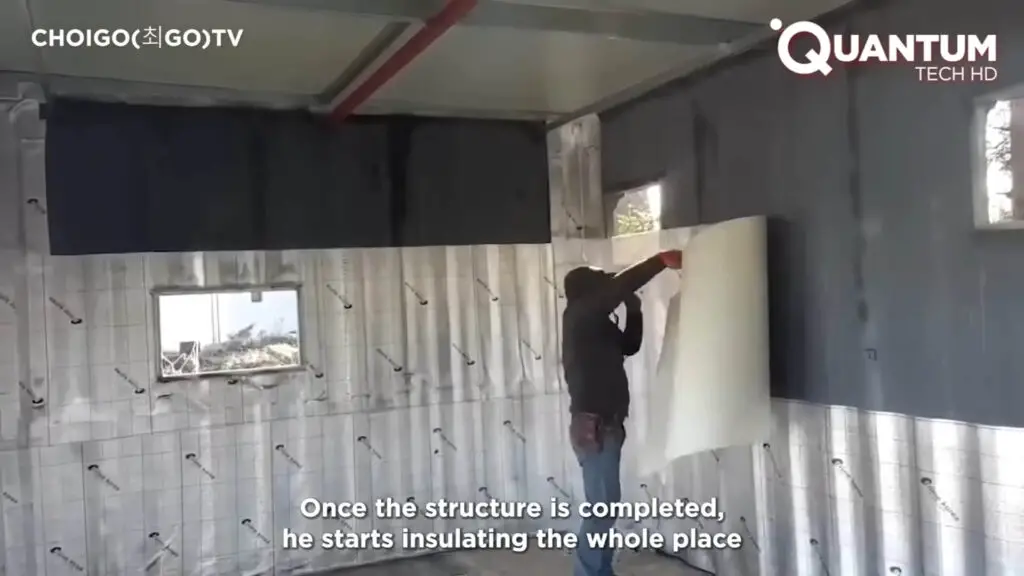Creating a home from a shipping container is not just about adapting to modern minimalist living but also about embracing innovation, sustainability, and cost-effectiveness.
In this comprehensive guide, we dive into the process of constructing a DIY container home from scratch, highlighting the crucial steps from foundation to finishing touches that ensure your container home is not just a living space but a sanctuary tailored to your lifestyle.

LAYING A STRONG FOUNDATION
Every sturdy home begins with a robust foundation, especially crucial for container homes that might be situated on uneven terrain.
A well-constructed foundation not only levels the ground but also protects your home from moisture infiltration, ensuring the durability and safety of the structure.
In this project, they emulate the resilience of shipping containers by opting for weathering steel, known for its strength, weldability, and rust resistance.
This alloy steel, comprising elements such as carbon and chromium, guarantees that even if the painted surface chips, the resulting surface rust will prevent further erosion.

PERFECTING INSULATION
Understanding that air leakage is a significant factor in the inefficiency of a home’s heating and cooling systems, correctly insulating your DIY container home is paramount.
Quality insulation does more than just maintain a consistent temperature; it also significantly reduces energy costs, which could be inflated by up to 15% with poor insulation.
Additionally, insulation plays a critical role in soundproofing your home, creating a quieter and more serene living environment.
CHOOSING THE RIGHT INSULATION MATERIAL
Rigid foam board stands out for its high R-values, providing continuous insulation and controlling moisture – a boon for preventing thermal bridging and air leaks.
Wood, with its natural insulating properties, offers an eco-friendly option that, when combined with fiber or foil insulation, greatly enhances your home’s thermal performance.
This efficient insulation means less energy is required to maintain comfortable temperatures, making your DIY container home both eco-conscious and cost-effective.

INSTALLING UNDERFLOOR HEATING
Embracing the traditional Korean Ondol heating system, underfloor heating is a luxurious yet practical feature for your container home.
This system not only distributes heat more evenly but also facilitates a shoe-free interior, aligning with Asian customs of indoor cleanliness and respect.
By incorporating such a heating solution, your DIY container home transcends conventional living spaces, offering warmth and comfort that touches the very soles of your feet.

INTERIOR DESIGN AND WATERPROOFING
As the main living spaces take shape, the focus shifts to interior design and waterproofing, particularly in wet areas such as bathrooms. Modern advancements have introduced decorative, waterproof wall panels that offer aesthetic appeal without compromising on functionality.
For flooring, tiles remain a versatile and waterproof option, available in various colors and designs to suit your taste.

THE TRADITIONAL AND THE CONTEMPORARY
The juxtaposition of traditional elements like tiled wet areas with contemporary advances in waterproofing materials illustrates the blend of heritage and modernity in DIY container home design.
This harmony between the old and the new not only enhances the functionality and aesthetic of your home but also tailors it to modern living standards while respecting cultural foundations.

ELEVATING DESIGN AND SECURITY
An elevated house design not only safeguards against potential flooding but also adds an architectural element that is both practical and visually appealing.
Security is another critical aspect, with smart locks becoming the norm in regions like South Korea, offering a keyless, secure entry to your home.
These modern features ensure your DIY container home is a safe, serene, and sustainable abode.
CONCLUSION
Building a DIY container home is more than assembling a structure—it’s about creating a personalized space that reflects your values and lifestyle.
From selecting the appropriate foundation and insulation to incorporating underfloor heating and modern security features, each step is a testament to innovation, sustainability, and functional design.
Whether nestled in nature or situated in an urban setting, your DIY container home is not just a place of residence but a sanctuary that offers comfort, warmth, and security.
Embrace the journey of creating your dream home, where every corner tells a story of innovation and personalization.
